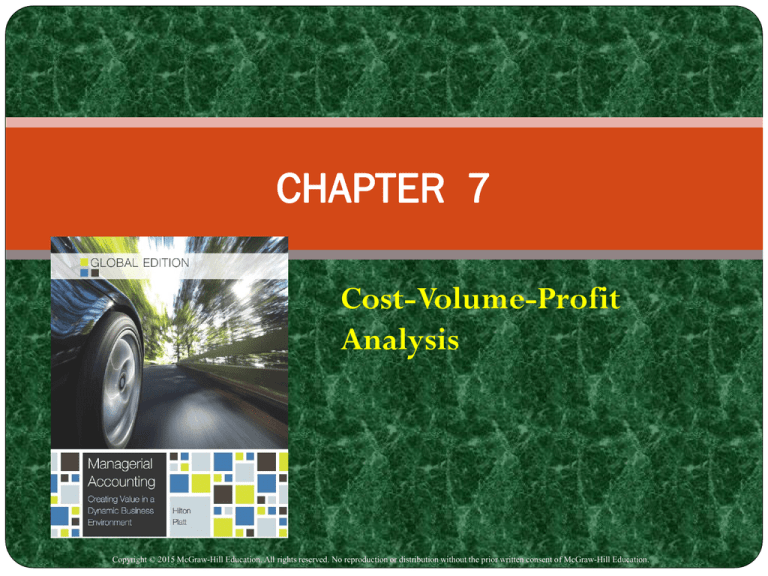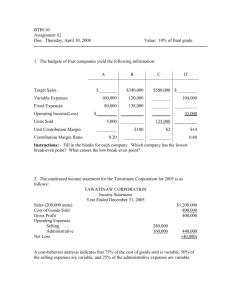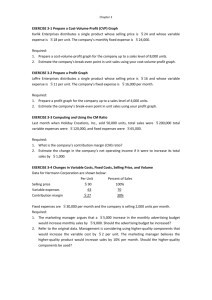
CHAPTER 7
Cost-Volume-Profit
Analysis
Copyright © 2015 McGraw-Hill Education. All rights reserved. No reproduction or distribution without the prior written consent of McGraw-Hill Education.
The Break-Even Point
The break-even point is the point in the volume of activity where the
organization’s revenues and expenses are equal.
Sales
$ 250,000
Less: variable expenses 150,000
Contribution margin
100,000
Less: fixed expenses
100,000
Net income
$
-
7-2
Equation Approach
Sales revenue – Variable expenses – Fixed expenses = Profit
Unit
Sales
sales × volume
price in units
Unit
Sales
variable × volume
expense in units
($500 × X) –
($300 × X)
– $80,000 = $0
($200X) – $80,000 = $0
X = 400 surf boards
7-3
Contribution-Margin Approach
Consider the following information
developed by the accountant at Curl, Inc.:
For each additional surf board sold, Curl
generates $200 in contribution margin.
Sales (500 surf boards)
Less: variable expenses
Contribution margin
Less: fixed expenses
Net income
Total
$250,000
150,000
$100,000
80,000
$ 20,000
Per Unit
$
500
300
$
200
Percent
100%
60%
40%
7-4
Contribution-Margin Approach
Fixed expenses
Break-even point
=
Unit contribution margin
(in units)
Sales (500 surf boards)
Less: variable expenses
Contribution margin
Less: fixed expenses
Net income
$80,000
$200
Total
$250,000
150,000
$100,000
80,000
$ 20,000
Per Unit
$
500
300
$
200
Percent
100%
60%
40%
= 400 surf boards
7-5
Contribution-Margin Approach
Here is the proof!
Sales (400 surf boards)
Less: variable expenses
Contribution margin
Less: fixed expenses
Net income
400 × $500 = $200,000
Total
$200,000
120,000
$ 80,000
80,000
$
-
Per Unit
$
500
300
$
200
Percent
100%
60%
40%
400 × $300 = $120,000
7-6
Contribution Margin Ratio
Calculate the break-even point in sales dollars rather than units
by using the contribution margin ratio.
Contribution margin
Sales
= CM Ratio
Fixed expense
Break-even point
=
CM Ratio
(in sales dollars)
7-7
Contribution Margin Ratio
Sales (400 surf boards)
Less: variable expenses
Contribution margin
Less: fixed expenses
Net income
$80,000
40%
=
Total
$200,000
120,000
$ 80,000
80,000
$
-
Per Unit
$
500
300
$
200
Percent
100%
60%
40%
$200,000 sales
7-8
Graphing Cost-Volume-Profit Relationships
Viewing CVP relationships in a graph gives managers a
perspective that can be obtained in no other way.
Consider the following information for Curl, Inc.:
300 units
Sales
$ 150,000
Less: variable expenses
90,000
Contribution margin
$ 60,000
Less: fixed expenses
80,000
Net income (loss)
$ (20,000)
400 units
$ 200,000
120,000
$ 80,000
80,000
$
-
500 units
$ 250,000
150,000
$ 100,000
80,000
$ 20,000
7-9
Cost-Volume-Profit Graph
450,000
400,000
350,000
Dollars
300,000
250,000
200,000
150,000
Fixed expenses
100,000
50,000
100
200
300
400
Units
500
600
700
800
7-10
Cost-Volume-Profit Graph
450,000
400,000
350,000
Dollars
300,000
250,000
200,000
150,000
Fixed expenses
100,000
50,000
100
200
300
400
Units
500
600
700
800
7-11
Cost-Volume-Profit Graph
450,000
400,000
350,000
Dollars
300,000
250,000
200,000
150,000
Fixed expenses
100,000
50,000
100
200
300
400
Units
500
600
700
800
7-12
Cost-Volume-Profit Graph
450,000
400,000
350,000
Dollars
300,000
250,000
200,000
150,000
Fixed expenses
100,000
50,000
100
200
300
400
Units
500
600
700
800
7-13
Cost-Volume-Profit Graph
450,000
400,000
350,000
Dollars
300,000
Break-even
point
250,000
200,000
150,000
Fixed expenses
100,000
50,000
100
200
300
400
Units
500
600
700
800
7-14
Profit-Volume Graph
Some managers like the profit-volume
graph because it focuses on profits and volume.
100,000
80,000
60,000
Break-even
point
Profit
40,000
20,000
0
(20,000)
`
100
200
300
400
Units
500
600
700
(40,000)
(60,000)
7-15
Target Net Profit
We can determine the number of surfboards that Curl must
sell to earn a profit of $100,000 using the contribution
margin approach.
Fixed expenses + Target profit
Unit contribution margin
$80,000 + $100,000
$200
=
Units sold to earn
the target profit
= 900 surf boards
7-16
Equation Approach
Sales revenue – Variable expenses – Fixed expenses = Profit
($500 × X) –
($300 × X) – $80,000 = $100,000
($200X) = $180,000
X = 900 surf boards
7-17
Effect of Income Taxes
Income taxes affect a company’s
CVP relationships. To earn a
particular after-tax net income, a
greater before-tax income will be
required.
Before-tax
Target after-tax net income
=
net income
1 - t
7-18
Applying CVP Analysis
Safety Margin
The difference between budgeted sales revenue and break-even
sales revenue.
The amount by which sales can drop before losses occur.
7-19
Safety Margin
Curl, Inc. has a break-even point of $200,000
in sales. If actual sales are $250,000, the safety margin is
$50,000, or 100 surf boards.
Sales
Less: variable expenses
Contribution margin
Less: fixed expenses
Net income
Break-even
sales
400 units
$ 200,000
120,000
80,000
80,000
$
-
Actual sales
500 units
$ 250,000
150,000
100,000
80,000
$
20,000
7-20
Changes in Fixed Costs
Curl is currently selling 500 surfboards per year.
The owner believes that an increase of $10,000 in the annual
advertising budget, would increase sales to 540 units.
Should the company increase the advertising budget?
7-21
Changes in Fixed Costs
Current
Sales
(500 Boards)
Sales
$
250,000
Less: variable expenses
150,000
Contribution margin
$
100,000
Less: fixed expenses
80,000
Net income
$
20,000
Proposed
Sales
(540 Boards)
$
270,000
162,000
$
108,000
90,000
$
18,000
540 units × $500 per unit = $270,000
$80,000 + $10,000 advertising = $90,000
7-22
Changes in Fixed Costs
Current
Sales will increase by
Sales
$20,000, but net income
(500 Boards)
decreased by $2,000.
Sales
$
250,000
Less: variable expenses
150,000
Contribution margin
$
100,000
Less: fixed expenses
80,000
Net income
$
20,000
Proposed
Sales
(540 Boards)
$
270,000
162,000
$
108,000
90,000
$
18,000
7-23
Changes in Unit
Contribution Margin
Because of increases in cost of raw materials, Curl’s
variable cost per unit has increased from $300 to $310
per surfboard. With no change in selling price per
unit, what will be the new break-even point?
($500 × X) –
($310 × X) – $80,000 = $0
X = 422 units (rounded)
7-24
Changes in Unit
Contribution Margin
Suppose Curl, Inc. increases the price of each surfboard to
$550. With no change in variable cost per unit, what will
be the new break-even point?
($550 × X) –
($300 × X) – $80,000 = $0
X = 320 units
7-25
Predicting Profit Given Expected Volume
Given:
Given:
Fixed expenses
Unit contribution margin
Target net profit
Fixed expenses
Unit contribution margin
Expected sales volume
Find: {req’d sales volume}
Find: {expected profit}
7-26
Predicting Profit Given
Expected Volume
In the coming year, Curl’s owner expects to sell 525
surfboards. The unit contribution margin is expected to
be $190, and fixed costs are expected to increase to
$90,000.
Total contribution
-
Fixed cost = Profit
($190 × 525) – $90,000 = X
X = $99,750 – $90,000
X = $9,750 profit
7-27
CVP Analysis with Multiple Products
For a company with more than one product, sales mix is the
relative combination in which a company’s products are
sold.
Different products have different selling prices, cost
structures, and contribution margins.
Let’s assume Curl sells surfboards and sail boards and see how we deal
with break-even analysis.
7-28
CVP Analysis with Multiple Products
Curl provides us with the following: information:
Description
Surfboards
Sailboards
Total sold
Unit
Unit
Number
Selling Variable Contribution
of
Price
Cost
Margin
Boards
$
500 $ 300 $
200
500
1,000
450
550
300
800
Number
Description of Boards
Surfboards
500
Sailboards
300
Total sold
800
% of
Total
62.5% (500 ÷ 800)
37.5% (300 ÷ 800)
100.0%
7-29
CVP Analysis with Multiple Products
Weighted-average unit contribution margin
Contribution
Weighted
Description
Margin
% of Total Contribution
Surfboards $
200
62.5% $
125.00
Sailboards
550
37.5%
206.25
Weighted-average contribution margin $
331.25
$200 × 62.5%
$550 × 37.5%
7-30
CVP Analysis with Multiple Products
Break-even point
Break-even
Fixed expenses
=
point
Weighted-average unit contribution margin
Break-even
=
point
$170,000
$331.25
Break-even
= 514 combined unit sales
point
7-31
CVP Analysis with Multiple Products
Break-even point
Break-even
point
Description
Surfboards
Sailboards
Total units
=
514 combined unit sales
Breakeven
Sales
514
514
% of
Individual
Total
Sales
62.5%
321
37.5%
193
514
7-32
CVP Relationships and the Income
Statement
A. Traditional Format
ACCUTIME COMPANY
Income Statement
For the Year Ended December 31, 20x1
Sales
Less:
Gross margin
Less: Operating expenses:
Selling expenses
Administrative expenses
Net income
$500,000
380,000
$120,000
$35,000
35,000
70,000
$50,000
7-33
CVP Relationships and the Income
Statement
B. Contribution Format
ACCUTIME COMPANY
Income Statement
For the Year Ended December 31, 20x1
Sales
Less: Variable expenses:
Variable manufacturing
Variable selling
Variable administrative
Contribution margin
Less: Fixed expenses:
Fixed manufacturing
Fixed selling
Fixed administrative
Net income
$500,000
$280,000
15,000
5,000
$100,000
20,000
30,000
300,000
$200,000
150,000
$50,000
7-34
Cost Structure and Operating Leverage
The cost structure of an organization is the relative proportion
of its fixed and variable costs.
Operating leverage is:
the extent to which an organization uses fixed costs in its cost
structure.
greatest in companies that have a high proportion of fixed costs in
relation to variable costs.
7-35
Measuring Operating Leverage
Operating leverage
factor
=
Contribution margin
Net income
Sales
Less: variable expenses
Contribution margin
Less: fixed expenses
Net income
$100,000
$20,000
Actual sales
500 Board
$ 250,000
150,000
100,000
80,000
$
20,000
= 5
7-36
Measuring Operating Leverage
A measure of how a percentage change in sales will affect profits. If
Curl increases its sales by 10%, what will be the percentage
increase in net income?
Percent increase in sales
Operating leverage factor ×
Percent increase in profits
10%
5
50%
7-37
Measuring Operating Leverage
A firm with proportionately high fixed costs has
relatively high operating leverage. On the other
hand, a firm with high operating leverage has a
relatively high break-even point.
7-38
End of Chapter 7
We made
it!
7-39







